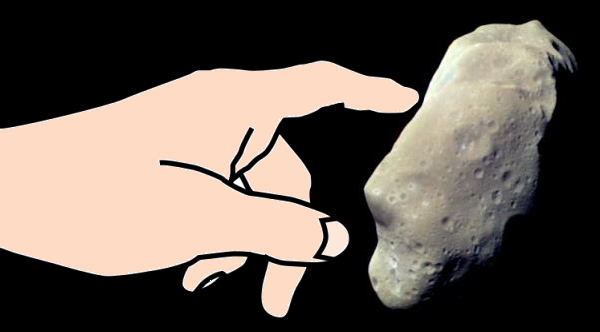=> Zurück zum Artikel
Ein Asteroid im Weltraum: wenn man mit dreitausend mal so vielen Newton an Kraft drückt wie die Beschleunigung im Metern pro Sekunde am Ende ist, dann hat man eine Masse von 3000 Kilogramm: © NASA Ralph Pfeifer ☛
Masse
Bildinfo und Lizenz
Bildinfo
Ein Asteroid im Weltraum: wenn man mit dreitausend mal so vielen Newton an Kraft drückt wie die Beschleunigung im Metern pro Sekunde am Ende ist, dann hat man eine Masse von 3000 Kilogramm: Der Komet Ida: 59,8 km lang und 18,6 km breit und rund 42 Billiarden Kilogramm schwer: der Asteroid Ida zählt zu den kleinere der Asteroiden. Originalbeschriftung: This color picture is made from images taken by the imaging system on the Galileo spacecraft about 14 minutes before its closest approach to asteroid 243 Ida on August 28, 1993, at a distance of about 10,500 kilometers (6,500 miles). The images used are from the sequence in which Ida's moon was originally discovered; the moon is visible to the right of the asteroid. This picture is made from images through the 4100-ångström (violet), 7560 Å (infrared) and 9680 Å (infrared) filters. The color is 'enhanced' in the sense that the CCD camera is sensitive to near-infrared wavelengths of light beyond human vision; a 'natural' color picture of this asteroid would appear mostly gray. Shadings in the image indicate changes in illumination angle on the many steep slopes of this irregular body as well as subtle color variations due to differences in the physical state and composition of the soil (regolith). There are brighter areas, appearing bluish in the picture, around craters on the upper left end of Ida, around the small bright crater near the center of the asteroid, and near the upper right-hand edge (the limb). This is a combination of more reflected blue light and greater absorption of near infrared light, suggesting a difference in the abundance or composition of iron-bearing minerals in these areas. Ida's moon also has a deeper near-infrared absorption and a different color in the violet than any area on this side of Ida. The moon is not identical in spectral properties to any area of Ida in view here, though its overall similarity in reflectance and general spectral type suggests that it is made of the same rock types basically. These data, combined with study of further imaging data and more detailed spectra from the Near Infrared Mapping Spectrometer, may allow scientists to determine whether the larger parent body of which Ida, its moon, and some other asteroids are fragments was a heated, differentiated object or made of relatively unaltered primitive chondritic material. Die Hand stammt aus der Sammlung gemeinfreier Bilder openclipart.org Die Collage stammt von Gunter Heim Source Asteroid
Created: August 28th, 1993 Source Hand
Created: October 6th, 2010 License asteroid
This image is from the NASA Imaga Library. On the website is the following note: NASA content - images, audio, video, and computer files used in the rendition of 3-dimensional models, such as texture maps and polygon data in any format - generally are not copyrighted. You may use this material for educational or informational purposes, including photo collections, textbooks, public exhibits, computer graphical simulations and Internet Web pages. This general permission extends to personal Web pages. [This note was copied from the image gallery site on March 4th, 2020] License hand
Warranty
No guarantee can be given as to the correctness of facts implied or explicitly stated. Usage is completey at your own risk. 💣 Originalseite
Das Bild ist Teil eines online-Lexikons. Rhetos Lernlexikon Mathematik, Aachen:  Ein Asteroid im Weltraum: wenn man mit dreitausend mal so vielen Newton an Kraft drückt wie die Beschleunigung im Metern pro Sekunde am Ende ist, dann hat man eine Masse von 3000 Kilogramm:
© NASA - Author: Ralph Pfeifer => Zurück zum Artikel
Ein Asteroid im Weltraum: wenn man mit dreitausend mal so vielen Newton an Kraft drückt wie die Beschleunigung im Metern pro Sekunde am Ende ist, dann hat man eine Masse von 3000 Kilogramm:
© NASA - Author: Ralph Pfeifer => Zurück zum Artikel
